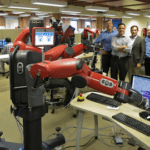The Future of Work is Coming: MIT Seeks Tech Solutions to Adapt to the Impending Transformation
Automation, artificial intelligence (AI) and the cloud are all dramatically changing the nature of work. Augmented by machines or by algorithms, how we work will be transformed — whether on a Guangzhou factory floor, in the cocoa farms of Ondo, or in high-rise offices in New York City.
Opinions differ about the likely impact of these digital transformations. Some believe these changes will continue to displace many workers in their wakes, eliminating their jobs, squeezing their wages and requiring them to learn new skills or move to new places.
Others argue that these shifts will create new jobs and entire industries we have yet to imagine. They will liberate us from rote tasks, increasing our productivity and leaving us ample time to explore our creativity and reach our full potential.
These varied predictions underscore one certainty: We don’t yet know how many jobs will be created or lost. But we do know that advances in technology will permanently impact the ways in which we work.
Building Better Work of the Future
The scope of these impending changes has led to no small amount of anxiety around the future of work. Even the term itself sounds vaguely foreboding — as if there were a question mark trailing it. As Liz Reynolds, executive director of MIT’s Work of the Future initiative, puts it, “We don’t say ‘future of work’ because there’s something so tentative about that formulation.”
And the truth is, there will always be work. The questions we’re trying to answer are: How will that work make us feel? Will we continue to derive from it a sense of purpose, community and identity? And crucially, will there be enough of it, at high enough incomes, to sustain the world’s growing population?
Since we’re tech optimists at MIT Solve, we believe there will be affirmative answers to those questions. But we know that left to their own devices, there’s no guarantee that these emerging technologies will evolve in ways that serve everyone. Leveraging them in ways that ensure equality — of opportunity and of outcomes — can’t be an afterthought. It will require deliberate planning and action, both in developing the tech innovations themselves and in preparing workers to utilize them.
That’s the goal of our Work of the Future Challenge. We’re looking for solutions that prepare current and future workforces for the coming transformations of work, whether they involve improved economic security, career flexibility or new income streams. If you’re an innovator or entrepreneur with a solution — whether you’ve just started building it, you’re running a pilot, or you’re ready to scale — we encourage you to apply. All solutions relevant to this topic are welcome, and they can come from nonprofit or for-profit companies or even pilot projects. But we’re MIT, so every solution must include technology — whether new or existing — as a key component.
The Types of Solutions We Need
To guide the future of work in a way that will benefit everyone, we need solutions that are not only tech-powered but also human-centric. These solutions can address the following topics:
- Upskilling, Reskilling and Job Matching: Existing jobs are more likely to evolve than to disappear entirely. But they’re changing fast — even when the job was already high-tech to begin with. For instance, the need for computer-aided design skills is replacing the need for coding skills. Workers need to quickly adapt, but the process of timely skilling workers to respond to market demands, and matching them to positions they’re capable of filling, is an expensive exercise. It’s also a shared responsibility – and a growing focus among entrepreneurs and enterprises.
- Data for Decision Making: It’s not easy to navigate the complex and rapidly changing landscape of the labor market. We must continually identify the skills employers need, and the companies, industries and geographies that need workers. This requires tracking, analyzing and communicating changes in an actionable and timely manner – and the key to accomplishing that is data.
- The No Collar Economy (or, if you prefer, the new collar economy): Not every job involves punching a time card or sitting in an office, and as we move from outsourcing to crowdsourcing, the gig economy will make up a growing percentage of the global economy. But the added flexibility for workers often comes with the stress of a lack of benefits and 401(k)s. We’re seeking solutions that ensure gig workers are not uber worked and underpaid.
- Human + Machine: We can design AI and robots to replace us — the possibility that’s driving much of the fear around the future or work. But we can also design them to augment our potential. The key is to invent machines that work WITH humans, not without them. How do we outsource the right tasks to machines, while keeping people at the center of work? Answering that question will be essential to developing tech that liberates us rather than displaces us.
- New Industries & Ethical Supply Chains: We believe that entire new industries and previously unimagined careers will emerge in this fourth industrial revolution. But how do we ensure that the voices of marginalized groups are included in designing the economy of the future? Ethical sourcing is a priority even among existing industries, and new technologies like blockchain can help make it easier for both producers and consumers to make better choices.
If the above goals inspire you, apply to become a Solver. Anyone anywhere can apply — our Challenges are open until July 1. Submit your solution today! If you don’t currently have a solution, you can also get involved by hosting a Solveathon or applying to become a member.
Hala Hanna is the managing director for community at Solve, an initiative of the Massachusetts Institute of Technology (MIT).
Photo by Adam Schultz/MIT Solve
Note: This post was adapted from an article on MIT Solve’s website.
- Categories
- Technology



